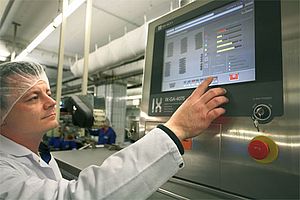Wolff, part of Germany's Lambertz Group and a manufacturer of high quality gingerbread, has installed two X-Ray Inspection Systems in order to deliver higher levels of product safety in both raw ingredients and its final packed product, leading to an overall improvement in production efficiency. While the most common location for an X-ray inspection system for food products is at the end of the line to enable it to detect contaminants from any part of the manufacturing and packing operation, the separate monitoring of raw materials can further increase safety, by allowing final inspection of the packed product to concentrate on a narrower range of potential problems. At Wolff's Nuremberg factory, shelled whole nuts, including hazelnuts, almonds, cashews and walnuts, arrive from different countries, where the conditions under which they are harvested and shelled vary considerably. As a result, levels of contaminants such as pieces of shell and stones vary too. Previously control of these contaminants was by visual inspection of contaminants, which was of limited effectiveness. This led to regular damage to the nut grinders by stones.
Now, the nuts are first emptied onto a conveyor belt, which takes them directly into the inspection system. The conveyor travels at speeds of 30 metres per second, enabling approximately two tonnes of material to be monitored and decontaminated every hour. Inspecting the final packs represented its own challenges. The ingredients of classic Oblaten gingerbread include oily seeds, candied orange peel and spices, as well as sugar, flour, syrup and powdered whole eggs, leading to a variation in density across a single piece. A typical 200g pack contains seven pieces standing on their edges in a tray, enclosed in clear plastic, meaning that the x-ray inspection beam has to pass through the entire width of each piece. “At first, we had our doubts whether this would work,” comments Achim Chast Quality Manager at Wolff. “But the Ishida inspection system could be calibrated to cope perfectly with this complex product.” Wolff is happy with the extra degree of safety provided by a system that can detect stone, glass, metal, plastic, hard rubber and wood with great reliability, and with the reassurance this provides to both retailers and end-users. The IX-GA X-ray system uses a unique self-learning Genetic Algorithm (GA) to ensure maximum detection sensitivity and reliability, while the place of contamination can also be accurately pinpointed. The system can pick up metal fragments of 0.5mm diameter (almost invisible to the human eye), as Wolff was able to demonstrate to its own satisfaction when comparing various competitor machines prior to purchase. Metal pieces three times this size would have been able to escape the metal detector previously used in this inspection role, while non-metallic contaminants would not have been machine-detected at any size. While the number of consumer complaints, mostly related to pieces of shell, was already very low, this has now been reduced by a further 80% since the installation of the Ishida X-Rays. Furthermore, every pack is traceable back to its X-ray image, protecting the company against claims without merit. “The upgrading achieved through the use of the X-ray technology goes beyond current requirements,” concludes Achim Chast. “It reflects our own sense of responsibility.”
The IX-GA X-ray system uses a unique self-learning Genetic Algorithm to ensure maximum detection sensitivity and reliability, while the place of contamination can also be accurately pinpointed Edited by Constanze Schmitz
X-Ray inspection systems
improves product safety in gingerbread factory
- by Ishida Europe Ltd
- February 17, 2011
- 7605 views



















